Starbucks Leadership and Management: Roles, Theories, and Contexts
VerifiedAdded on 2020/07/22
|11
|3011
|43
Report
AI Summary
This report provides a comprehensive analysis of leadership and management, focusing on the roles of leaders and managers within the context of Starbucks. The assignment begins by differentiating between the characteristics and responsibilities of leaders and managers, highlighting their distinct functions and the importance of each role in organizational success. It explores various leadership theories and models, including situational, systematic, and contingency leadership, evaluating their strengths and weaknesses. The report then applies these concepts to different situational contexts, such as decision-making, risk-taking, team building, and conflict management, demonstrating how leaders and managers adapt their approaches. The report concludes by offering insights into how effective leadership and management contribute to organizational effectiveness and the attainment of business goals, using Starbucks as a practical case study throughout the analysis.

Management Operations
(Project 1)
(Project 1)
Paraphrase This Document
Need a fresh take? Get an instant paraphrase of this document with our AI Paraphraser
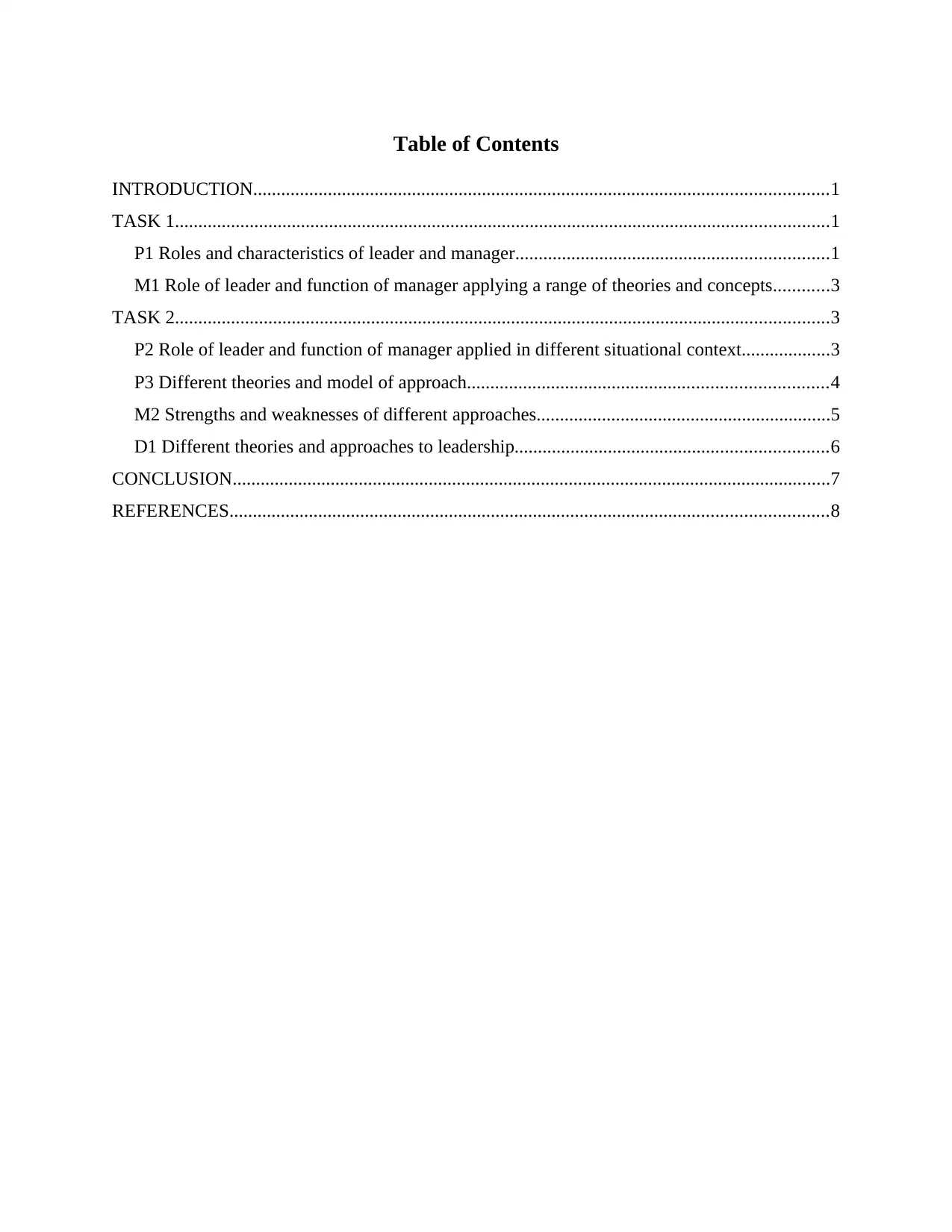
Table of Contents
INTRODUCTION...........................................................................................................................1
TASK 1............................................................................................................................................1
P1 Roles and characteristics of leader and manager...................................................................1
M1 Role of leader and function of manager applying a range of theories and concepts............3
TASK 2............................................................................................................................................3
P2 Role of leader and function of manager applied in different situational context...................3
P3 Different theories and model of approach.............................................................................4
M2 Strengths and weaknesses of different approaches...............................................................5
D1 Different theories and approaches to leadership...................................................................6
CONCLUSION................................................................................................................................7
REFERENCES................................................................................................................................8
INTRODUCTION...........................................................................................................................1
TASK 1............................................................................................................................................1
P1 Roles and characteristics of leader and manager...................................................................1
M1 Role of leader and function of manager applying a range of theories and concepts............3
TASK 2............................................................................................................................................3
P2 Role of leader and function of manager applied in different situational context...................3
P3 Different theories and model of approach.............................................................................4
M2 Strengths and weaknesses of different approaches...............................................................5
D1 Different theories and approaches to leadership...................................................................6
CONCLUSION................................................................................................................................7
REFERENCES................................................................................................................................8

⊘ This is a preview!⊘
Do you want full access?
Subscribe today to unlock all pages.

Trusted by 1+ million students worldwide
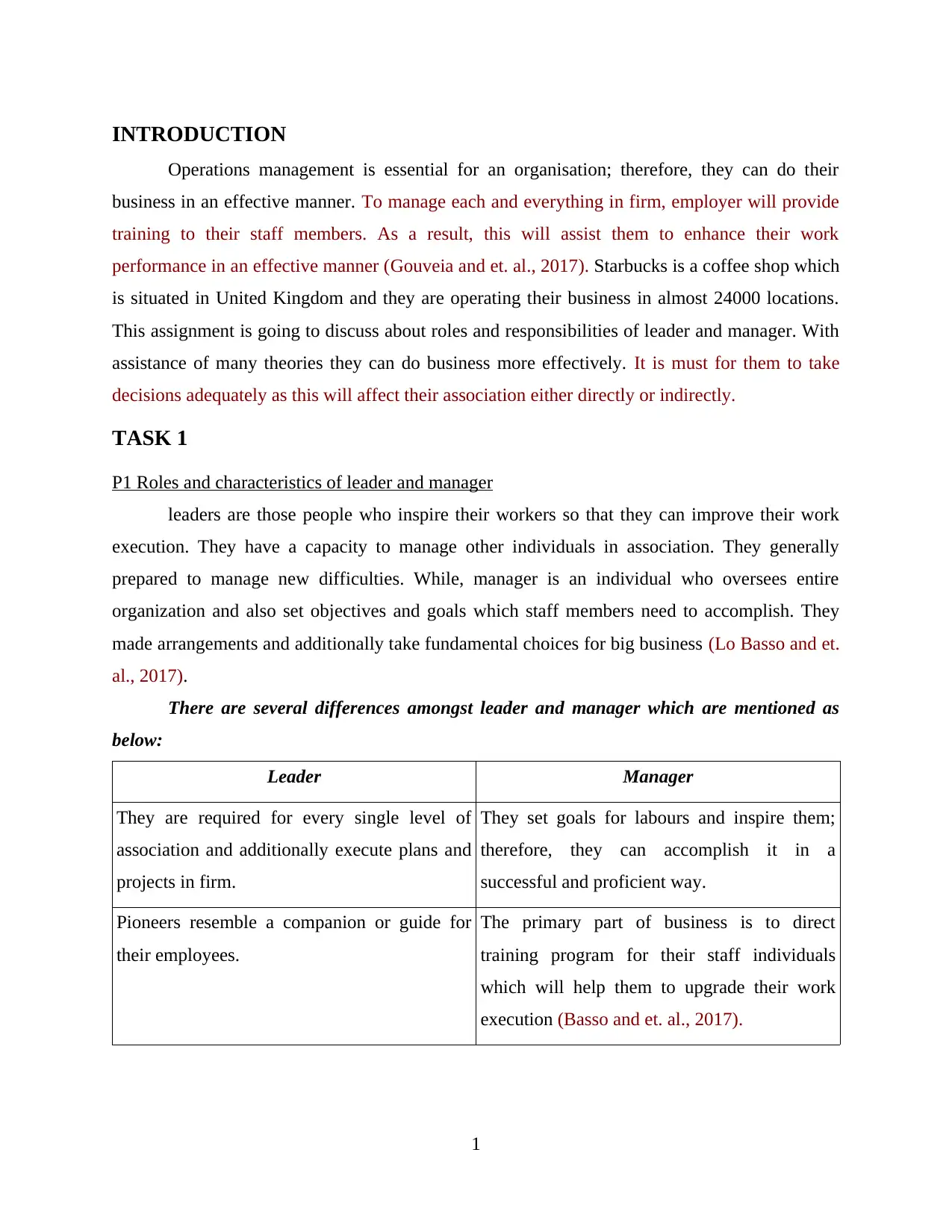
INTRODUCTION
Operations management is essential for an organisation; therefore, they can do their
business in an effective manner. To manage each and everything in firm, employer will provide
training to their staff members. As a result, this will assist them to enhance their work
performance in an effective manner (Gouveia and et. al., 2017). Starbucks is a coffee shop which
is situated in United Kingdom and they are operating their business in almost 24000 locations.
This assignment is going to discuss about roles and responsibilities of leader and manager. With
assistance of many theories they can do business more effectively. It is must for them to take
decisions adequately as this will affect their association either directly or indirectly.
TASK 1
P1 Roles and characteristics of leader and manager
leaders are those people who inspire their workers so that they can improve their work
execution. They have a capacity to manage other individuals in association. They generally
prepared to manage new difficulties. While, manager is an individual who oversees entire
organization and also set objectives and goals which staff members need to accomplish. They
made arrangements and additionally take fundamental choices for big business (Lo Basso and et.
al., 2017).
There are several differences amongst leader and manager which are mentioned as
below:
Leader Manager
They are required for every single level of
association and additionally execute plans and
projects in firm.
They set goals for labours and inspire them;
therefore, they can accomplish it in a
successful and proficient way.
Pioneers resemble a companion or guide for
their employees.
The primary part of business is to direct
training program for their staff individuals
which will help them to upgrade their work
execution (Basso and et. al., 2017).
1
Operations management is essential for an organisation; therefore, they can do their
business in an effective manner. To manage each and everything in firm, employer will provide
training to their staff members. As a result, this will assist them to enhance their work
performance in an effective manner (Gouveia and et. al., 2017). Starbucks is a coffee shop which
is situated in United Kingdom and they are operating their business in almost 24000 locations.
This assignment is going to discuss about roles and responsibilities of leader and manager. With
assistance of many theories they can do business more effectively. It is must for them to take
decisions adequately as this will affect their association either directly or indirectly.
TASK 1
P1 Roles and characteristics of leader and manager
leaders are those people who inspire their workers so that they can improve their work
execution. They have a capacity to manage other individuals in association. They generally
prepared to manage new difficulties. While, manager is an individual who oversees entire
organization and also set objectives and goals which staff members need to accomplish. They
made arrangements and additionally take fundamental choices for big business (Lo Basso and et.
al., 2017).
There are several differences amongst leader and manager which are mentioned as
below:
Leader Manager
They are required for every single level of
association and additionally execute plans and
projects in firm.
They set goals for labours and inspire them;
therefore, they can accomplish it in a
successful and proficient way.
Pioneers resemble a companion or guide for
their employees.
The primary part of business is to direct
training program for their staff individuals
which will help them to upgrade their work
execution (Basso and et. al., 2017).
1
Paraphrase This Document
Need a fresh take? Get an instant paraphrase of this document with our AI Paraphraser

There are some functions of manager which has to be perform by him in an adequate
way, are described as below:
Planning: It is basic for each enterprise to design there exercises viably, with the goal
that they can run their operations all the more adequately. Moreover, it includes how director
reach to objectives and targets all the more fittingly.
Organising: It is fundamental for manager to compose every single capacity of firm,
which will help them to finish their work all the more effectively and efficiently.
Staffing: It is fundamental obligation of supervisor to appoint right assignment to right
person, in this manner, they can finish their objectives and goals within specific period of time
(Jacobs and Chase, 2017).
Coordinating: It is fundamental for director to make coordination among each and every
division. It might incorporates appropriate conversation, training and in addition supervision by
regulatory division.
Leadership roles by Mintzberg: Role of leader will differ as per their working level. Therefore,
there are some roles which has to performed by them effectively and efficiently. In this context,
some roles are provided by Mintzberg which is mentioned as beneath:
Interpersonal roles: It is basic for supervisor to accomplish their duties as well as
obligations in an effective way. They can inspire and coordinate their staff individuals, which
will help to enhance their work execution. It is fundamental for them to keep up adequate data in
a proper way, by utilizing mail, meeting etc.
Informational role: It is vital for superior to know needs and requirements of their
clients, in this way, they can fulfil their requisites which aid them to improve their revenues. To
know about their demands they will conduct survey, this will assist them to take benefits from
their competitors (Ribeiro and de Sousa Jabbour, 2017). They can also acquire data with
assistance of secondary sources, such as reports, newspaper, magazine, internet and many more.
Decisional role: It is essential for organization to enhance their items as well as
administrations and also dispatch new stocks for their clients. They need to make spending plan
for their business, so they can do their work within budget and use available resources in a
proficient manner.
Characteristics of leader and manager: It can be stated as beneath:
They both must be honest towards their labours and staff members.
2
way, are described as below:
Planning: It is basic for each enterprise to design there exercises viably, with the goal
that they can run their operations all the more adequately. Moreover, it includes how director
reach to objectives and targets all the more fittingly.
Organising: It is fundamental for manager to compose every single capacity of firm,
which will help them to finish their work all the more effectively and efficiently.
Staffing: It is fundamental obligation of supervisor to appoint right assignment to right
person, in this manner, they can finish their objectives and goals within specific period of time
(Jacobs and Chase, 2017).
Coordinating: It is fundamental for director to make coordination among each and every
division. It might incorporates appropriate conversation, training and in addition supervision by
regulatory division.
Leadership roles by Mintzberg: Role of leader will differ as per their working level. Therefore,
there are some roles which has to performed by them effectively and efficiently. In this context,
some roles are provided by Mintzberg which is mentioned as beneath:
Interpersonal roles: It is basic for supervisor to accomplish their duties as well as
obligations in an effective way. They can inspire and coordinate their staff individuals, which
will help to enhance their work execution. It is fundamental for them to keep up adequate data in
a proper way, by utilizing mail, meeting etc.
Informational role: It is vital for superior to know needs and requirements of their
clients, in this way, they can fulfil their requisites which aid them to improve their revenues. To
know about their demands they will conduct survey, this will assist them to take benefits from
their competitors (Ribeiro and de Sousa Jabbour, 2017). They can also acquire data with
assistance of secondary sources, such as reports, newspaper, magazine, internet and many more.
Decisional role: It is essential for organization to enhance their items as well as
administrations and also dispatch new stocks for their clients. They need to make spending plan
for their business, so they can do their work within budget and use available resources in a
proficient manner.
Characteristics of leader and manager: It can be stated as beneath:
They both must be honest towards their labours and staff members.
2
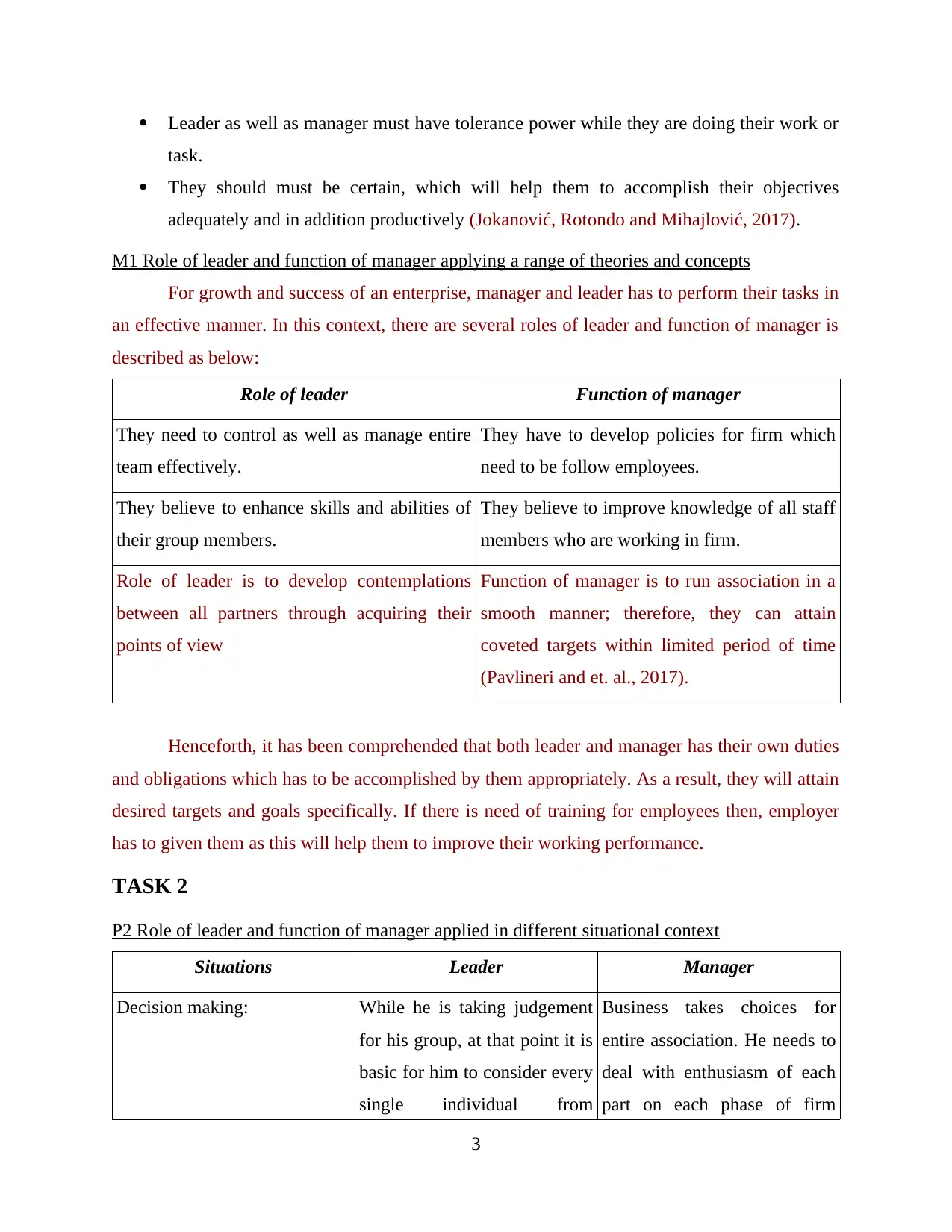
Leader as well as manager must have tolerance power while they are doing their work or
task.
They should must be certain, which will help them to accomplish their objectives
adequately and in addition productively (Jokanović, Rotondo and Mihajlović, 2017).
M1 Role of leader and function of manager applying a range of theories and concepts
For growth and success of an enterprise, manager and leader has to perform their tasks in
an effective manner. In this context, there are several roles of leader and function of manager is
described as below:
Role of leader Function of manager
They need to control as well as manage entire
team effectively.
They have to develop policies for firm which
need to be follow employees.
They believe to enhance skills and abilities of
their group members.
They believe to improve knowledge of all staff
members who are working in firm.
Role of leader is to develop contemplations
between all partners through acquiring their
points of view
Function of manager is to run association in a
smooth manner; therefore, they can attain
coveted targets within limited period of time
(Pavlineri and et. al., 2017).
Henceforth, it has been comprehended that both leader and manager has their own duties
and obligations which has to be accomplished by them appropriately. As a result, they will attain
desired targets and goals specifically. If there is need of training for employees then, employer
has to given them as this will help them to improve their working performance.
TASK 2
P2 Role of leader and function of manager applied in different situational context
Situations Leader Manager
Decision making: While he is taking judgement
for his group, at that point it is
basic for him to consider every
single individual from
Business takes choices for
entire association. He needs to
deal with enthusiasm of each
part on each phase of firm
3
task.
They should must be certain, which will help them to accomplish their objectives
adequately and in addition productively (Jokanović, Rotondo and Mihajlović, 2017).
M1 Role of leader and function of manager applying a range of theories and concepts
For growth and success of an enterprise, manager and leader has to perform their tasks in
an effective manner. In this context, there are several roles of leader and function of manager is
described as below:
Role of leader Function of manager
They need to control as well as manage entire
team effectively.
They have to develop policies for firm which
need to be follow employees.
They believe to enhance skills and abilities of
their group members.
They believe to improve knowledge of all staff
members who are working in firm.
Role of leader is to develop contemplations
between all partners through acquiring their
points of view
Function of manager is to run association in a
smooth manner; therefore, they can attain
coveted targets within limited period of time
(Pavlineri and et. al., 2017).
Henceforth, it has been comprehended that both leader and manager has their own duties
and obligations which has to be accomplished by them appropriately. As a result, they will attain
desired targets and goals specifically. If there is need of training for employees then, employer
has to given them as this will help them to improve their working performance.
TASK 2
P2 Role of leader and function of manager applied in different situational context
Situations Leader Manager
Decision making: While he is taking judgement
for his group, at that point it is
basic for him to consider every
single individual from
Business takes choices for
entire association. He needs to
deal with enthusiasm of each
part on each phase of firm
3
⊘ This is a preview!⊘
Do you want full access?
Subscribe today to unlock all pages.

Trusted by 1+ million students worldwide
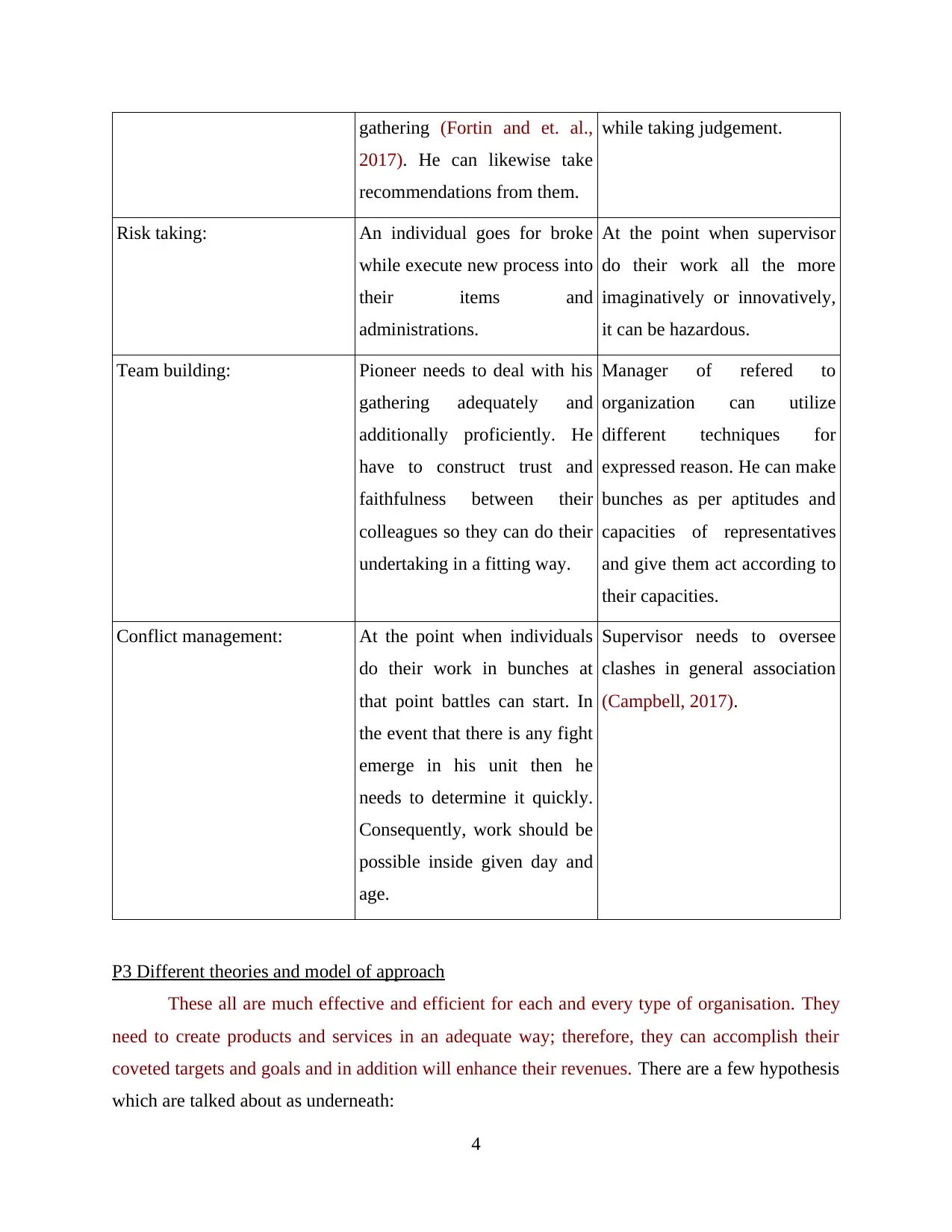
gathering (Fortin and et. al.,
2017). He can likewise take
recommendations from them.
while taking judgement.
Risk taking: An individual goes for broke
while execute new process into
their items and
administrations.
At the point when supervisor
do their work all the more
imaginatively or innovatively,
it can be hazardous.
Team building: Pioneer needs to deal with his
gathering adequately and
additionally proficiently. He
have to construct trust and
faithfulness between their
colleagues so they can do their
undertaking in a fitting way.
Manager of refered to
organization can utilize
different techniques for
expressed reason. He can make
bunches as per aptitudes and
capacities of representatives
and give them act according to
their capacities.
Conflict management: At the point when individuals
do their work in bunches at
that point battles can start. In
the event that there is any fight
emerge in his unit then he
needs to determine it quickly.
Consequently, work should be
possible inside given day and
age.
Supervisor needs to oversee
clashes in general association
(Campbell, 2017).
P3 Different theories and model of approach
These all are much effective and efficient for each and every type of organisation. They
need to create products and services in an adequate way; therefore, they can accomplish their
coveted targets and goals and in addition will enhance their revenues. There are a few hypothesis
which are talked about as underneath:
4
2017). He can likewise take
recommendations from them.
while taking judgement.
Risk taking: An individual goes for broke
while execute new process into
their items and
administrations.
At the point when supervisor
do their work all the more
imaginatively or innovatively,
it can be hazardous.
Team building: Pioneer needs to deal with his
gathering adequately and
additionally proficiently. He
have to construct trust and
faithfulness between their
colleagues so they can do their
undertaking in a fitting way.
Manager of refered to
organization can utilize
different techniques for
expressed reason. He can make
bunches as per aptitudes and
capacities of representatives
and give them act according to
their capacities.
Conflict management: At the point when individuals
do their work in bunches at
that point battles can start. In
the event that there is any fight
emerge in his unit then he
needs to determine it quickly.
Consequently, work should be
possible inside given day and
age.
Supervisor needs to oversee
clashes in general association
(Campbell, 2017).
P3 Different theories and model of approach
These all are much effective and efficient for each and every type of organisation. They
need to create products and services in an adequate way; therefore, they can accomplish their
coveted targets and goals and in addition will enhance their revenues. There are a few hypothesis
which are talked about as underneath:
4
Paraphrase This Document
Need a fresh take? Get an instant paraphrase of this document with our AI Paraphraser

Situational leadership: This theory was gotten in actuality of understanding criticalness
of workers in different conditions and also how authority ought to be controlled according to
circumstance request (Majidi and et. al., 2017). It was comprehended that same organization
technique can not be connected on all conditions. Every one has their own answer and ought to
be managed as necessities be. Every individual wants to finish their work and additionally they
need inspiration for this in like manner. By utilizing same assets without fail, individual can't get
spurred. In this manner, it is fundamental for chief to give them motivation as indicated by
circumstances. So that, he must be adaptable which will help him to adopt changes effectively
and can take care of any issue instantly (Leadership theories, 2017).
Systematic leadership: This organization approach helps by and large change of staff
members and firm. Starbucks must be clear with itself that what kind of organization and why it
is required in affiliation so they get what they require and not what is given to them. The
organized action focuses on three one of a kind levels particularly bunches who are connected
with organization, than organization lastly singular managers (Alanqar and et. al., 2017). It can
be impact managers successfully with the goal that their discernment can changed by utilizing
this initiative approach. In the event that works are not playing out their task well, at that point it
isn't basic that they committed any error in reality framework may likewise mistaken.
Contingency leadership: This speculation is connected with situational administration.
As indicated by this, style of direction and in addition circumstance can influence working of
pioneers. They need to respond as indicated by conditions of concern. Employer of Starbucks
receive this hypothesis so he can confront environment and take judgements in a suitable
manner. It likewise helps to clarify relationship among organization as well as workers.
Specialists must be fulfilled from their guide which will help them to feel good while they are
doing their work.
M2 Strengths and weaknesses of different approaches
There are various strengths as well as weaknesses which are associated with various
approaches are mentioned as beneath:
Situational leadership:
Strengths Weaknesses
People who are following this It can not be implement on every
5
of workers in different conditions and also how authority ought to be controlled according to
circumstance request (Majidi and et. al., 2017). It was comprehended that same organization
technique can not be connected on all conditions. Every one has their own answer and ought to
be managed as necessities be. Every individual wants to finish their work and additionally they
need inspiration for this in like manner. By utilizing same assets without fail, individual can't get
spurred. In this manner, it is fundamental for chief to give them motivation as indicated by
circumstances. So that, he must be adaptable which will help him to adopt changes effectively
and can take care of any issue instantly (Leadership theories, 2017).
Systematic leadership: This organization approach helps by and large change of staff
members and firm. Starbucks must be clear with itself that what kind of organization and why it
is required in affiliation so they get what they require and not what is given to them. The
organized action focuses on three one of a kind levels particularly bunches who are connected
with organization, than organization lastly singular managers (Alanqar and et. al., 2017). It can
be impact managers successfully with the goal that their discernment can changed by utilizing
this initiative approach. In the event that works are not playing out their task well, at that point it
isn't basic that they committed any error in reality framework may likewise mistaken.
Contingency leadership: This speculation is connected with situational administration.
As indicated by this, style of direction and in addition circumstance can influence working of
pioneers. They need to respond as indicated by conditions of concern. Employer of Starbucks
receive this hypothesis so he can confront environment and take judgements in a suitable
manner. It likewise helps to clarify relationship among organization as well as workers.
Specialists must be fulfilled from their guide which will help them to feel good while they are
doing their work.
M2 Strengths and weaknesses of different approaches
There are various strengths as well as weaknesses which are associated with various
approaches are mentioned as beneath:
Situational leadership:
Strengths Weaknesses
People who are following this It can not be implement on every
5
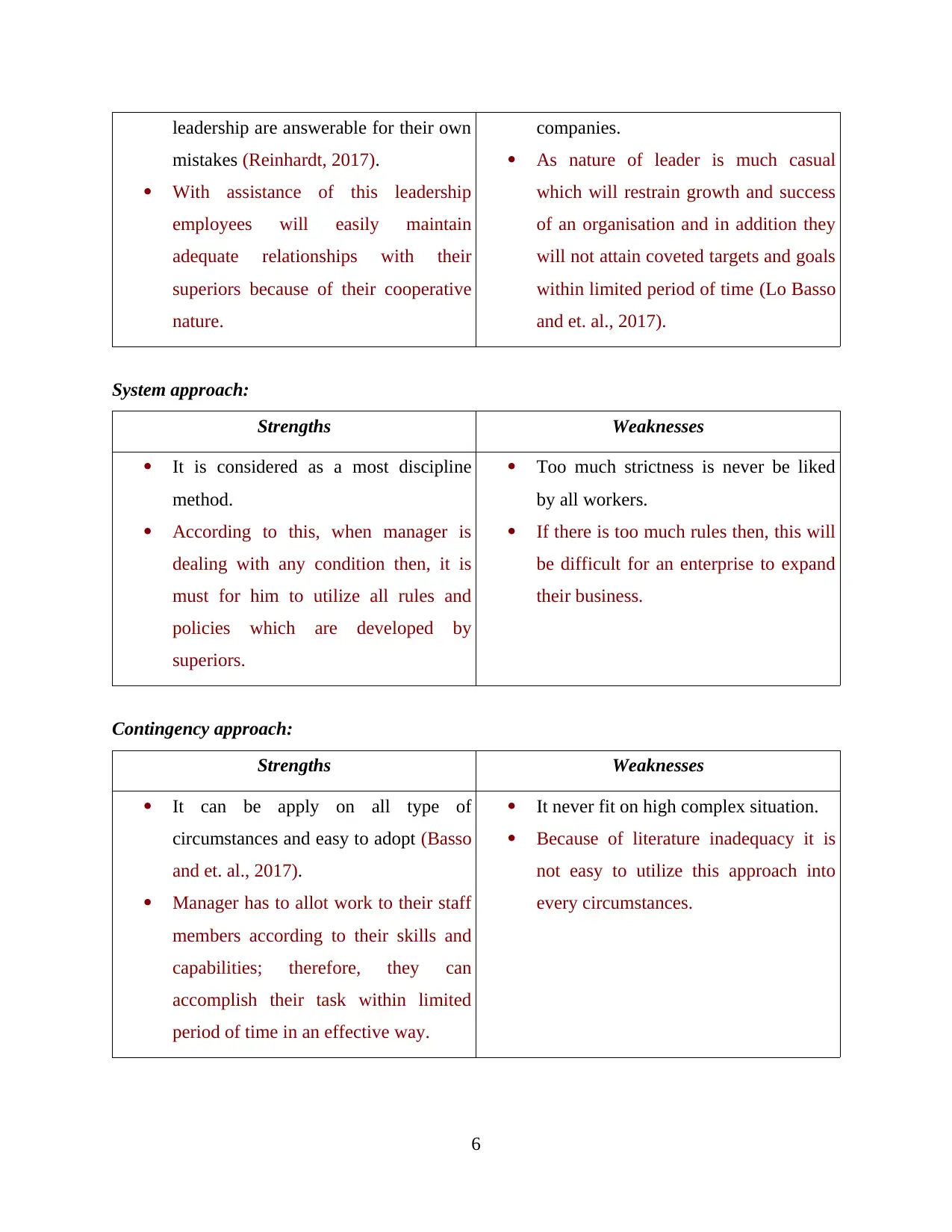
leadership are answerable for their own
mistakes (Reinhardt, 2017).
With assistance of this leadership
employees will easily maintain
adequate relationships with their
superiors because of their cooperative
nature.
companies.
As nature of leader is much casual
which will restrain growth and success
of an organisation and in addition they
will not attain coveted targets and goals
within limited period of time (Lo Basso
and et. al., 2017).
System approach:
Strengths Weaknesses
It is considered as a most discipline
method.
According to this, when manager is
dealing with any condition then, it is
must for him to utilize all rules and
policies which are developed by
superiors.
Too much strictness is never be liked
by all workers.
If there is too much rules then, this will
be difficult for an enterprise to expand
their business.
Contingency approach:
Strengths Weaknesses
It can be apply on all type of
circumstances and easy to adopt (Basso
and et. al., 2017).
Manager has to allot work to their staff
members according to their skills and
capabilities; therefore, they can
accomplish their task within limited
period of time in an effective way.
It never fit on high complex situation.
Because of literature inadequacy it is
not easy to utilize this approach into
every circumstances.
6
mistakes (Reinhardt, 2017).
With assistance of this leadership
employees will easily maintain
adequate relationships with their
superiors because of their cooperative
nature.
companies.
As nature of leader is much casual
which will restrain growth and success
of an organisation and in addition they
will not attain coveted targets and goals
within limited period of time (Lo Basso
and et. al., 2017).
System approach:
Strengths Weaknesses
It is considered as a most discipline
method.
According to this, when manager is
dealing with any condition then, it is
must for him to utilize all rules and
policies which are developed by
superiors.
Too much strictness is never be liked
by all workers.
If there is too much rules then, this will
be difficult for an enterprise to expand
their business.
Contingency approach:
Strengths Weaknesses
It can be apply on all type of
circumstances and easy to adopt (Basso
and et. al., 2017).
Manager has to allot work to their staff
members according to their skills and
capabilities; therefore, they can
accomplish their task within limited
period of time in an effective way.
It never fit on high complex situation.
Because of literature inadequacy it is
not easy to utilize this approach into
every circumstances.
6
⊘ This is a preview!⊘
Do you want full access?
Subscribe today to unlock all pages.

Trusted by 1+ million students worldwide
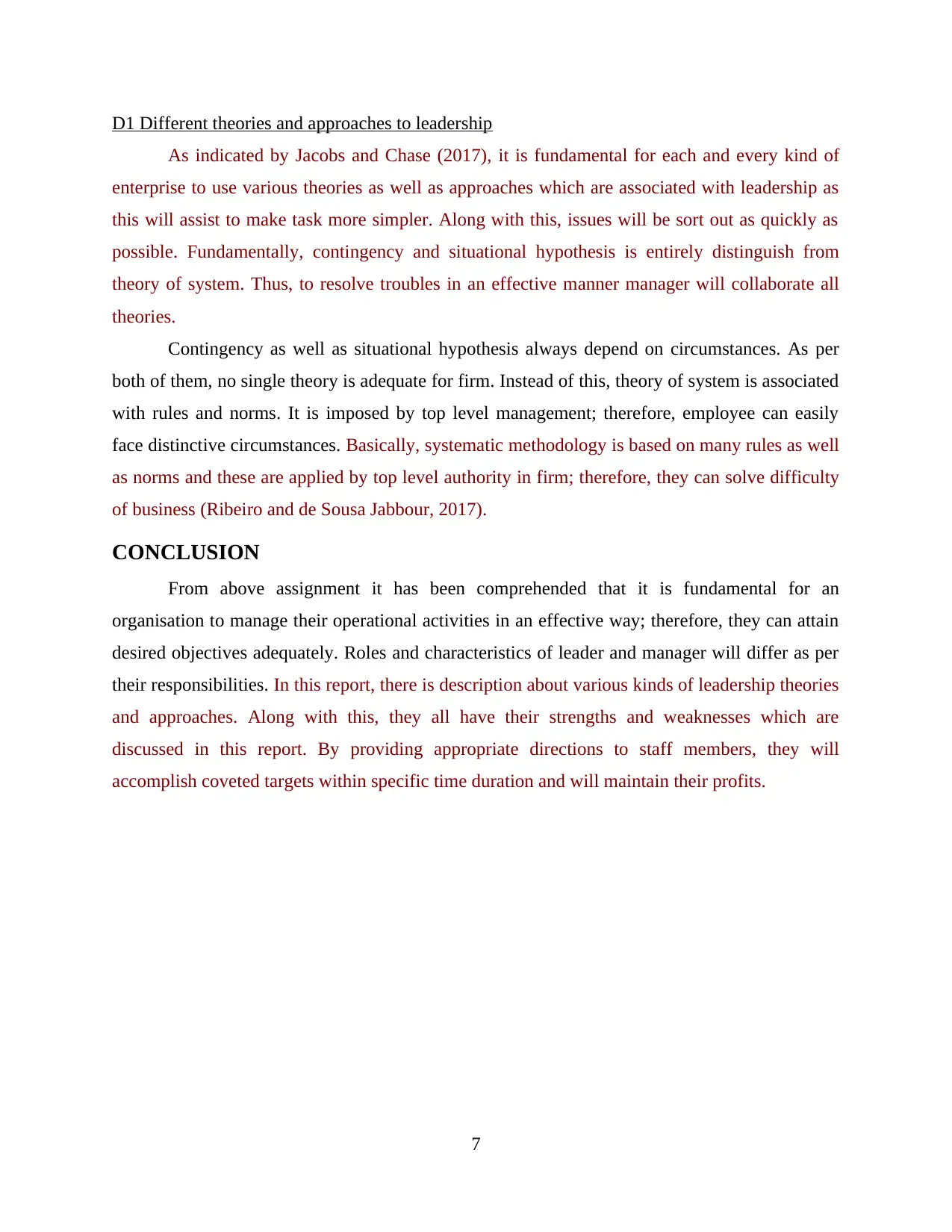
D1 Different theories and approaches to leadership
As indicated by Jacobs and Chase (2017), it is fundamental for each and every kind of
enterprise to use various theories as well as approaches which are associated with leadership as
this will assist to make task more simpler. Along with this, issues will be sort out as quickly as
possible. Fundamentally, contingency and situational hypothesis is entirely distinguish from
theory of system. Thus, to resolve troubles in an effective manner manager will collaborate all
theories.
Contingency as well as situational hypothesis always depend on circumstances. As per
both of them, no single theory is adequate for firm. Instead of this, theory of system is associated
with rules and norms. It is imposed by top level management; therefore, employee can easily
face distinctive circumstances. Basically, systematic methodology is based on many rules as well
as norms and these are applied by top level authority in firm; therefore, they can solve difficulty
of business (Ribeiro and de Sousa Jabbour, 2017).
CONCLUSION
From above assignment it has been comprehended that it is fundamental for an
organisation to manage their operational activities in an effective way; therefore, they can attain
desired objectives adequately. Roles and characteristics of leader and manager will differ as per
their responsibilities. In this report, there is description about various kinds of leadership theories
and approaches. Along with this, they all have their strengths and weaknesses which are
discussed in this report. By providing appropriate directions to staff members, they will
accomplish coveted targets within specific time duration and will maintain their profits.
7
As indicated by Jacobs and Chase (2017), it is fundamental for each and every kind of
enterprise to use various theories as well as approaches which are associated with leadership as
this will assist to make task more simpler. Along with this, issues will be sort out as quickly as
possible. Fundamentally, contingency and situational hypothesis is entirely distinguish from
theory of system. Thus, to resolve troubles in an effective manner manager will collaborate all
theories.
Contingency as well as situational hypothesis always depend on circumstances. As per
both of them, no single theory is adequate for firm. Instead of this, theory of system is associated
with rules and norms. It is imposed by top level management; therefore, employee can easily
face distinctive circumstances. Basically, systematic methodology is based on many rules as well
as norms and these are applied by top level authority in firm; therefore, they can solve difficulty
of business (Ribeiro and de Sousa Jabbour, 2017).
CONCLUSION
From above assignment it has been comprehended that it is fundamental for an
organisation to manage their operational activities in an effective way; therefore, they can attain
desired objectives adequately. Roles and characteristics of leader and manager will differ as per
their responsibilities. In this report, there is description about various kinds of leadership theories
and approaches. Along with this, they all have their strengths and weaknesses which are
discussed in this report. By providing appropriate directions to staff members, they will
accomplish coveted targets within specific time duration and will maintain their profits.
7
Paraphrase This Document
Need a fresh take? Get an instant paraphrase of this document with our AI Paraphraser
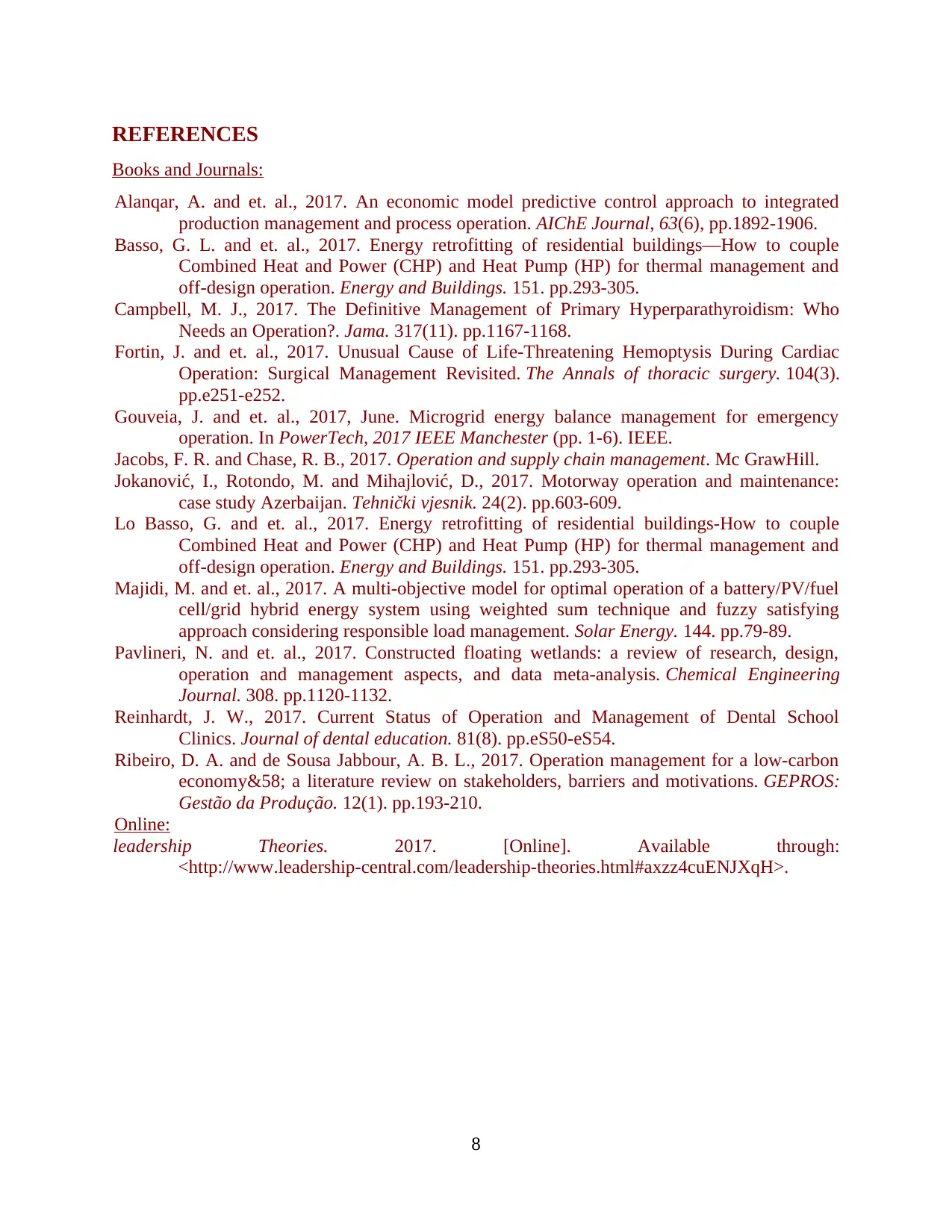
REFERENCES
Books and Journals:
Alanqar, A. and et. al., 2017. An economic model predictive control approach to integrated
production management and process operation. AIChE Journal, 63(6), pp.1892-1906.
Basso, G. L. and et. al., 2017. Energy retrofitting of residential buildings—How to couple
Combined Heat and Power (CHP) and Heat Pump (HP) for thermal management and
off-design operation. Energy and Buildings. 151. pp.293-305.
Campbell, M. J., 2017. The Definitive Management of Primary Hyperparathyroidism: Who
Needs an Operation?. Jama. 317(11). pp.1167-1168.
Fortin, J. and et. al., 2017. Unusual Cause of Life-Threatening Hemoptysis During Cardiac
Operation: Surgical Management Revisited. The Annals of thoracic surgery. 104(3).
pp.e251-e252.
Gouveia, J. and et. al., 2017, June. Microgrid energy balance management for emergency
operation. In PowerTech, 2017 IEEE Manchester (pp. 1-6). IEEE.
Jacobs, F. R. and Chase, R. B., 2017. Operation and supply chain management. Mc GrawHill.
Jokanović, I., Rotondo, M. and Mihajlović, D., 2017. Motorway operation and maintenance:
case study Azerbaijan. Tehnički vjesnik. 24(2). pp.603-609.
Lo Basso, G. and et. al., 2017. Energy retrofitting of residential buildings-How to couple
Combined Heat and Power (CHP) and Heat Pump (HP) for thermal management and
off-design operation. Energy and Buildings. 151. pp.293-305.
Majidi, M. and et. al., 2017. A multi-objective model for optimal operation of a battery/PV/fuel
cell/grid hybrid energy system using weighted sum technique and fuzzy satisfying
approach considering responsible load management. Solar Energy. 144. pp.79-89.
Pavlineri, N. and et. al., 2017. Constructed floating wetlands: a review of research, design,
operation and management aspects, and data meta-analysis. Chemical Engineering
Journal. 308. pp.1120-1132.
Reinhardt, J. W., 2017. Current Status of Operation and Management of Dental School
Clinics. Journal of dental education. 81(8). pp.eS50-eS54.
Ribeiro, D. A. and de Sousa Jabbour, A. B. L., 2017. Operation management for a low-carbon
economy&58; a literature review on stakeholders, barriers and motivations. GEPROS:
Gestão da Produção. 12(1). pp.193-210.
Online:
leadership Theories. 2017. [Online]. Available through:
<http://www.leadership-central.com/leadership-theories.html#axzz4cuENJXqH>.
8
Books and Journals:
Alanqar, A. and et. al., 2017. An economic model predictive control approach to integrated
production management and process operation. AIChE Journal, 63(6), pp.1892-1906.
Basso, G. L. and et. al., 2017. Energy retrofitting of residential buildings—How to couple
Combined Heat and Power (CHP) and Heat Pump (HP) for thermal management and
off-design operation. Energy and Buildings. 151. pp.293-305.
Campbell, M. J., 2017. The Definitive Management of Primary Hyperparathyroidism: Who
Needs an Operation?. Jama. 317(11). pp.1167-1168.
Fortin, J. and et. al., 2017. Unusual Cause of Life-Threatening Hemoptysis During Cardiac
Operation: Surgical Management Revisited. The Annals of thoracic surgery. 104(3).
pp.e251-e252.
Gouveia, J. and et. al., 2017, June. Microgrid energy balance management for emergency
operation. In PowerTech, 2017 IEEE Manchester (pp. 1-6). IEEE.
Jacobs, F. R. and Chase, R. B., 2017. Operation and supply chain management. Mc GrawHill.
Jokanović, I., Rotondo, M. and Mihajlović, D., 2017. Motorway operation and maintenance:
case study Azerbaijan. Tehnički vjesnik. 24(2). pp.603-609.
Lo Basso, G. and et. al., 2017. Energy retrofitting of residential buildings-How to couple
Combined Heat and Power (CHP) and Heat Pump (HP) for thermal management and
off-design operation. Energy and Buildings. 151. pp.293-305.
Majidi, M. and et. al., 2017. A multi-objective model for optimal operation of a battery/PV/fuel
cell/grid hybrid energy system using weighted sum technique and fuzzy satisfying
approach considering responsible load management. Solar Energy. 144. pp.79-89.
Pavlineri, N. and et. al., 2017. Constructed floating wetlands: a review of research, design,
operation and management aspects, and data meta-analysis. Chemical Engineering
Journal. 308. pp.1120-1132.
Reinhardt, J. W., 2017. Current Status of Operation and Management of Dental School
Clinics. Journal of dental education. 81(8). pp.eS50-eS54.
Ribeiro, D. A. and de Sousa Jabbour, A. B. L., 2017. Operation management for a low-carbon
economy&58; a literature review on stakeholders, barriers and motivations. GEPROS:
Gestão da Produção. 12(1). pp.193-210.
Online:
leadership Theories. 2017. [Online]. Available through:
<http://www.leadership-central.com/leadership-theories.html#axzz4cuENJXqH>.
8
1 out of 11
Related Documents
Your All-in-One AI-Powered Toolkit for Academic Success.
+13062052269
info@desklib.com
Available 24*7 on WhatsApp / Email
![[object Object]](/_next/static/media/star-bottom.7253800d.svg)
Unlock your academic potential
Copyright © 2020–2025 A2Z Services. All Rights Reserved. Developed and managed by ZUCOL.





